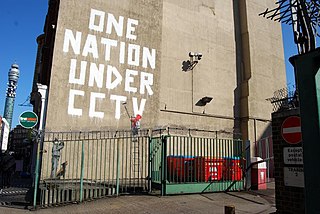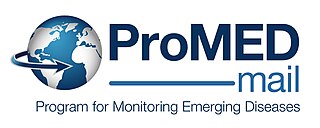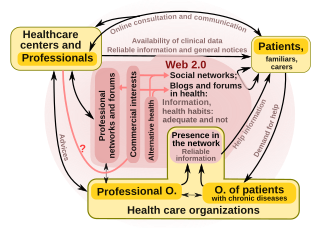Related Research Articles

Privacy is the ability of an individual or group to seclude themselves or information about themselves, and thereby express themselves selectively.
The ethics of technology is a sub-field of ethics addressing the ethical questions specific to the Technology Age, the transitional shift in society wherein personal computers and subsequent devices provide for the quick and easy transfer of information. Technology ethics is the application of ethical thinking to the growing concerns of technology as new technologies continue to rise in prominence.

In public health, contact tracing is the process of identifying persons who may have been exposed to an infected person ("contacts") and subsequent collection of further data to assess transmission. By tracing the contacts of infected individuals, testing them for infection, and isolating or treating the infected, this public health tool aims to reduce infections in the population. In addition to infection control, contact tracing serves as a means to identify high-risk and medically vulnerable populations who might be exposed to infection and facilitate appropriate medical care. In doing so, public health officials utilize contact tracing to conduct disease surveillance and prevent outbreaks. In cases of diseases of uncertain infectious potential, contact tracing is also sometimes performed to learn about disease characteristics, including infectiousness. Contact tracing is not always the most efficient method of addressing infectious disease. In areas of high disease prevalence, screening or focused testing may be more cost-effective.
Public health surveillance is, according to the World Health Organization (WHO), "the continuous, systematic collection, analysis and interpretation of health-related data needed for the planning, implementation, and evaluation of public health practice." Public health surveillance may be used to track emerging health-related issues at an early stage and find active solutions in a timely manner. Surveillance systems are generally called upon to provide information regarding when and where health problems are occurring and who is affected.

Waterborne diseases are conditions caused by pathogenic micro-organisms that are transmitted by water. These diseases can be spread while bathing, washing, drinking water, or by eating food exposed to contaminated water. They are a pressing issue in rural areas amongst developing countries all over the world. While diarrhea and vomiting are the most commonly reported symptoms of waterborne illness, other symptoms can include skin, ear, respiratory, or eye problems. Lack of clean water supply, sanitation and hygiene (WASH) are major causes for the spread of waterborne diseases in a community. Therefore, reliable access to clean drinking water and sanitation is the main method to prevent waterborne diseases.

Program for Monitoring Emerging Diseases is among the largest publicly available emerging diseases and outbreak reporting systems in the world. The purpose of ProMED is to promote communication amongst the international infectious disease community, including scientists, physicians, veterinarians, epidemiologists, public health professionals, and others interested in infectious diseases on a global scale. Founded in 1994, ProMED has pioneered the concept of electronic, Internet-based emerging disease and outbreak detection reporting. In 1999, ProMED became a program of the International Society for Infectious Diseases. As of 2016, ProMED has more than 75,000 subscribers in over 185 countries. With an average of 13 posts per day, ProMED provides users with up-to-date information concerning infectious disease outbreaks on a global scale.
Tele-epidemiology is the application of telecommunications to epidemiological research and application, including space-based and internet-based systems.

"Health 2.0" is a term introduced in the mid-2000s, as the subset of health care technologies mirroring the wider Web 2.0 movement. It has been defined variously as including social media, user-generated content, and cloud-based and mobile technologies. Some Health 2.0 proponents see these technologies as empowering patients to have greater control over their own health care and diminishing medical paternalism. Critics of the technologies have expressed concerns about possible misinformation and violations of patient privacy.

The pandemic H1N1/09 virus is a swine origin influenza A virus subtype H1N1 strain that was responsible for the 2009 swine flu pandemic. This strain is often called swine flu by the public media. For other names, see the Nomenclature section below.
The social data revolution is the shift in human communication patterns towards increased personal information sharing and its related implications, made possible by the rise of social networks in the early 2000s. This phenomenon has resulted in the accumulation of unprecedented amounts of public data.
Infoveillance is a type of syndromic surveillance that specifically utilizes information found online. The term, along with the term infodemiology, was coined by Gunther Eysenbach to describe research that uses online information to gather information about human behavior.
Digital health is a discipline that includes digital care programs, technologies with health, healthcare, living, and society to enhance the efficiency of healthcare delivery and to make medicine more personalized and precise. It uses information and communication technologies to facilitate understanding of health problems and challenges faced by people receiving medical treatment and social prescribing in more personalised and precise ways. The definitions of digital health and its remits overlap in many ways with those of health and medical informatics.

Google Flu Trends (GFT) was a web service operated by Google. It provided estimates of influenza activity for more than 25 countries. By aggregating Google Search queries, it attempted to make accurate predictions about flu activity. This project was first launched in 2008 by Google.org to help predict outbreaks of flu.
Infodemiology was defined by Gunther Eysenbach in the early 2000s as information epidemiology. It is an area of science research focused on scanning the internet for user-contributed health-related content, with the ultimate goal of improving public health. It is also defined as the science of mitigating public health problems resulting from an infodemic.
Data philanthropy describes a form of collaboration in which private sector companies share data for public benefit. There are multiple uses of data philanthropy being explored from humanitarian, corporate, human rights, and academic use. Since introducing the term in 2011, the United Nations Global Pulse has advocated for a global "data philanthropy movement".
John Brownstein is a Canadian epidemiologist and Professor of Medicine at the Harvard Medical School as well as the Chief Innovation Officer at Boston Children’s Hospital. His research focuses on development of computational methods in epidemiology for applications to public health also known as computational epidemiology or e-epidemiology He is also the founder of several global public health surveillance systems including HealthMap. He is most known for his work on global tracking of disease outbreaks.
Crowdmapping is a subtype of crowdsourcing by which aggregation of crowd-generated inputs such as captured communications and social media feeds are combined with geographic data to create a digital map that is as up-to-date as possible on events such as wars, humanitarian crises, crime, elections, or natural disasters. Such maps are typically created collaboratively by people coming together over the Internet.
Data shadows refer to the information that a person leaves behind unintentionally while taking part in daily activities such as checking their e-mails, scrolling through social media or even by using their debit or credit card.
An infodemic is a rapid and far-reaching spread of both accurate and inaccurate information about certain issues. The word is a portmanteau of "information" and "epidemic" and is used as a metaphor to describe how misinformation and disinformation can spread like a virus from person to person and affect people like a disease. This term, originally coined in 2003 by David Rothkopf, rose to prominence in 2020 during the COVID-19 pandemic.

COVID-19 surveillance involves monitoring the spread of the coronavirus disease in order to establish the patterns of disease progression. The World Health Organization (WHO) recommends active surveillance, with focus of case finding, testing and contact tracing in all transmission scenarios. COVID-19 surveillance is expected to monitor epidemiological trends, rapidly detect new cases, and based on this information, provide epidemiological information to conduct risk assessment and guide disease preparedness.
References
- 1 2 3 4 5 Albrechtslund, Anders (2008). "Online Social Networking as Participatory Surveillance". First Monday. 13 (3). doi: 10.5210/fm.v13i3.2142 .
- 1 2 3 4 Iverson, Samuel A.; et al. (2016). "Avian Cholera Emergence in Arctic-Nesting Northern Common Eiders: Using Community-Based, Participatory Surveillance to Delineate Disease Outbreak Patterns and Predict Transmission Risk". Ecology and Society. 21 (4). doi: 10.5751/ES-08873-210412 .
- 1 2 Velasco, Edward (2014). "Social Media and Internet-Based Data in Global Systems for Public Health Surveillance: A Systematic Review". Milbank Quarterly. 92 (1): 7–33. doi:10.1111/1468-0009.12038. PMC 3955375 . PMID 24597553.
- 1 2 3 4 5 6 Signorini, Alessio; et al. (2011). "The Use of Twitter to Track Levels of Disease Activity and Public Concern in the U.S. during the Influenza A H1N1 Pandemic". PLOS ONE. 6 (5): e19467. Bibcode:2011PLoSO...619467S. doi: 10.1371/journal.pone.0019467 . PMC 3087759 . PMID 21573238.
- ↑ Wójcik, Octawia P. (2014). "Public Health for the People: Participatory Infectious Disease Surveillance in the Digital Age". Emerging Themes in Epidemiology. 11: 7. doi: 10.1186/1742-7622-11-7 . PMC 4078360 . PMID 24991229.
- 1 2 3 4 5 Andrejevic, Mark (2002). "The Work of Watching One Another: Lateral Surveillance, Risk, and Governance". Surveillance & Society. 2 (4). doi: 10.24908/ss.v2i4.3359 .
- ↑ Monahan, Torin (2006). "Counter-surveillance as Political Intervention?". Social Semiotics. 16 (4): 515–534. doi:10.1080/10350330601019769. S2CID 17875607.
- ↑ Gilliom, John; Monahan, Torin (2012). "Everyday resistance". In Ball, Kirstie; Haggerty, Kevin D.; Lyon, David (eds.). Routledge Handbook of Surveillance Studies. Routledge. pp. 405–411. ISBN 978-1-138-02602-5.
- 1 2 3 Koskela, Hille (2002). "Webcams, TV Shows and Mobile Phones: Empowering Exhibitionism". Surveillance & Society. 2 (2/3). doi: 10.24908/ss.v2i2/3.3374 .
- 1 2 Eysenbach, Gunther (2009). "Infodemiology and Infoveillance: Framework for an Emerging Set of Public Health Informatics Methods to Analyze Search, Communication and Publication Behavior on the Internet". Journal of Medical Internet Research. 11 (1): e11. doi: 10.2196/jmir.1157 . PMC 2762766 . PMID 19329408.
- 1 2 3 Neto, Onicio Leal (September 3, 2019). "Participatory Surveillance Based on Crowdsourcing During the Rio 2016 Olympic Games Using the Guardians of Health Platform: Descriptive Study". JMIR Public Health and Surveillance. 6 (2): e16119. doi: 10.2196/16119 . PMC 7175192 . PMID 32254042.
- 1 2 Tang, Lu; et al. (2018). "Social Media and Outbreaks of Emerging Infectious Diseases: A Systematic Review of Literature". American Journal of Infection Control. 46 (9): 962–72. doi:10.1016/j.ajic.2018.02.010. PMC 7115293 . PMID 29628293.
- ↑ Syed-Abdul, Shabbir; et al. (2016). Social Media and Health Crisis Communication During Epidemics. Amsterdam: Elsevier/Academic Press. pp. 42–66.
- 1 2 Mahroum, Naim; et al. (2018). "Public Reaction to Chikungunya Outbreaks in Italy—Insights from an Extensive Novel Data Streams-Based Structural Equation Modeling Analysis". PLOS ONE. 13 (5): e0197337. Bibcode:2018PLoSO..1397337M. doi: 10.1371/journal.pone.0197337 . PMC 5968406 . PMID 29795578.
- 1 2 Choi, Jihye; et al. (2016). "Web-Based Infectious Disease Surveillance Systems and Public Health Perspectives: a Systematic Review". BMC Public Health. 16 (1): 1238. doi: 10.1186/s12889-016-3893-0 . PMC 5146908 . PMID 27931204.
- 1 2 3 4 5 6 MacAllister, Julia M. (2017). "The Doxing Dilemma: Seeking a Remedy for the Malicious Publication of Personal Information". Fordham Law Review. 85 (5): 2451.